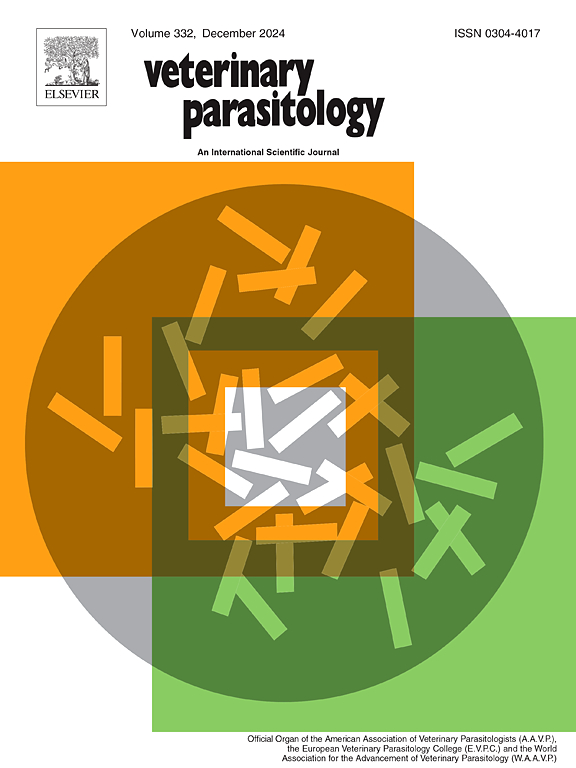Acaricidal activity of Myrcia splendens essential oils on Rhipicephalus microplus larvae
IF 2
2区 农林科学
Q2 PARASITOLOGY
引用次数: 0
Abstract
Rhipicephalus microplus is a major pest in Brazilian livestock, causing significant economic losses. Current control methods have drawbacks such as high costs, the need for specialized professionals and variable product effectiveness. Myrcia splendens extracts and essential oils are known for their antimicrobial properties, but there is no research on their acaricidal activity. This study aimed to investigate the chemical composition, acaricidal, anticholinesterase and cytotoxic activities of essential oils from two chemotypes (A and B) of M. splendens. Chemical composition was analyzed by Gas Chromatography coupled with Flame Ionization Detection (GC/FID) and Mass Spectrometry (GC/MS). The analysis revealed that the essential oils were rich in sesquiterpenes, with carotol (18.08 %) being predominant in chemotype A, while (2E,6E)-methyl farnesoate (42.64 %) was predominant in chemotype B. The oils exhibited acaricidal activity against R. microplus larvae in a concentration-dependent manner, with chemotype A showing the highest potency (LC50 = 4.06 mg/mL). The oils also inhibited acetylcholinesterase activity (p < 0.05), a potential target for acaricides, with chemotype B showing greater activity (IC50 = 0.14 mg/mL), suggesting this as a mechanism for their acaricidal effect. Cytotoxicity testing in Vero cell cultures showed that only chemotype A reduced cell viability by 19 % at the highest concentration (2 mg/mL). In conclusion, M. splendens essential oils exhibit in vitro anti-tick activity with low toxicity, with chemotype A being more effective.
桃金娘精油对小棘头螨幼虫的杀螨活性
微型鼻头虫是巴西家畜的主要害虫,造成重大经济损失。目前的控制方法存在成本高、需要专业人员和产品效果多变等缺点。桃金娘提取物和精油以其抗菌特性而闻名,但对其杀螨活性尚无研究。本研究旨在研究两种化学型(A型和B型)芨芨草精油的化学成分、杀螨活性、抗胆碱酯酶活性和细胞毒活性。化学成分分析采用气相色谱-火焰电离检测(GC/FID)和质谱(GC/MS)分析。结果表明,精油中含有丰富的倍半萜,其中A型以胡萝卜醇(18.08 %)为主,b型以(2E,6E)-法脂酸甲酯(42.64 %)为主。精油对小褐家蚕幼虫的杀螨活性呈浓度依赖性,其中A型的效价最高(LC50 = 4.06 mg/mL)。该精油还能抑制乙酰胆碱酯酶活性(p <; 0.05),乙酰胆碱酯酶是杀螨剂的潜在靶点,其中化学型B表现出更大的活性(IC50 = 0.14 mg/mL),表明这可能是其杀螨作用的机制。Vero细胞培养的细胞毒性测试表明,在最高浓度(2 mg/mL)下,只有A型化学型使细胞活力降低了19% %。综上所述,splendens精油具有较低毒性的体外抗蜱活性,其中A型更有效。
本文章由计算机程序翻译,如有差异,请以英文原文为准。
求助全文
约1分钟内获得全文
求助全文
来源期刊

Veterinary parasitology
农林科学-寄生虫学
CiteScore
5.30
自引率
7.70%
发文量
126
审稿时长
36 days
期刊介绍:
The journal Veterinary Parasitology has an open access mirror journal,Veterinary Parasitology: X, sharing the same aims and scope, editorial team, submission system and rigorous peer review.
This journal is concerned with those aspects of helminthology, protozoology and entomology which are of interest to animal health investigators, veterinary practitioners and others with a special interest in parasitology. Papers of the highest quality dealing with all aspects of disease prevention, pathology, treatment, epidemiology, and control of parasites in all domesticated animals, fall within the scope of the journal. Papers of geographically limited (local) interest which are not of interest to an international audience will not be accepted. Authors who submit papers based on local data will need to indicate why their paper is relevant to a broader readership.
Parasitological studies on laboratory animals fall within the scope of the journal only if they provide a reasonably close model of a disease of domestic animals. Additionally the journal will consider papers relating to wildlife species where they may act as disease reservoirs to domestic animals, or as a zoonotic reservoir. Case studies considered to be unique or of specific interest to the journal, will also be considered on occasions at the Editors'' discretion. Papers dealing exclusively with the taxonomy of parasites do not fall within the scope of the journal.
 求助内容:
求助内容: 应助结果提醒方式:
应助结果提醒方式:


